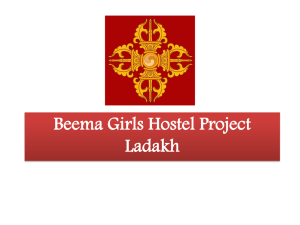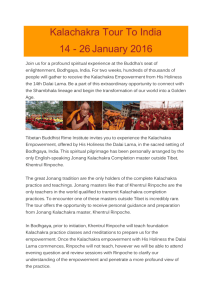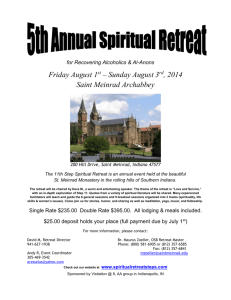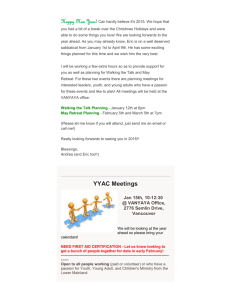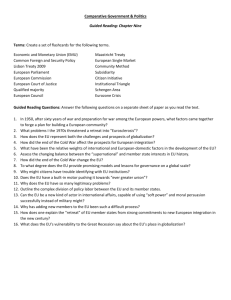Khyunga Rinpoche - Vajra Publications
advertisement
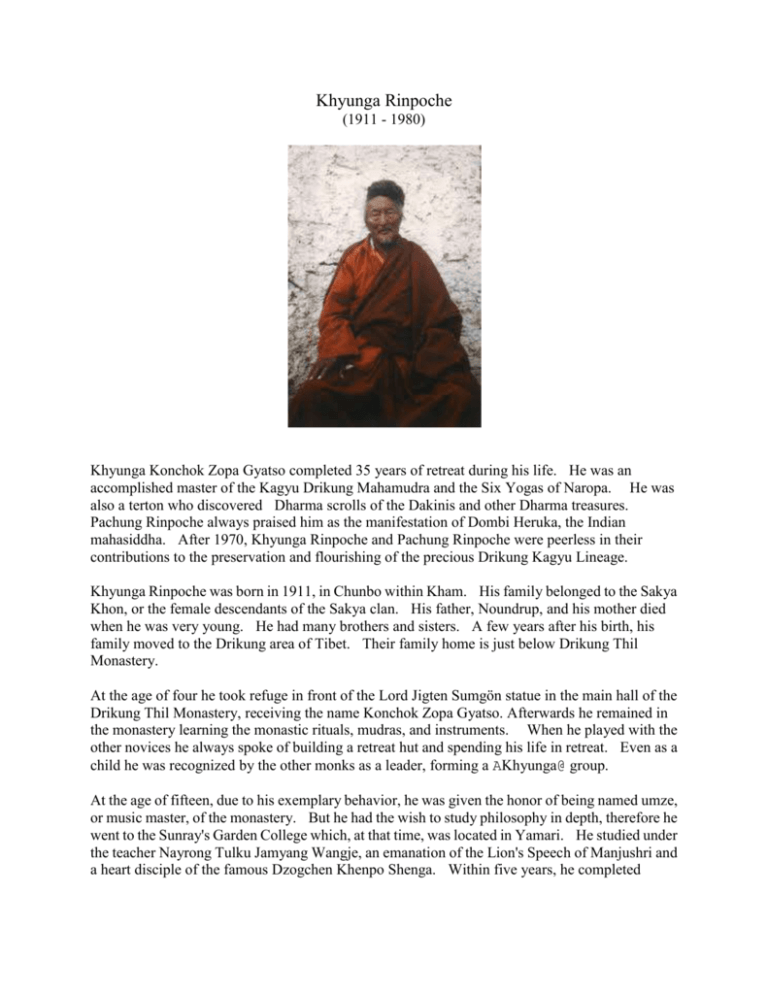
Khyunga Rinpoche (1911 - 1980) Khyunga Konchok Zopa Gyatso completed 35 years of retreat during his life. He was an accomplished master of the Kagyu Drikung Mahamudra and the Six Yogas of Naropa. He was also a terton who discovered Dharma scrolls of the Dakinis and other Dharma treasures. Pachung Rinpoche always praised him as the manifestation of Dombi Heruka, the Indian mahasiddha. After 1970, Khyunga Rinpoche and Pachung Rinpoche were peerless in their contributions to the preservation and flourishing of the precious Drikung Kagyu Lineage. Khyunga Rinpoche was born in 1911, in Chunbo within Kham. His family belonged to the Sakya Khon, or the female descendants of the Sakya clan. His father, Noundrup, and his mother died when he was very young. He had many brothers and sisters. A few years after his birth, his family moved to the Drikung area of Tibet. Their family home is just below Drikung Thil Monastery. At the age of four he took refuge in front of the Lord Jigten Sumgön statue in the main hall of the Drikung Thil Monastery, receiving the name Konchok Zopa Gyatso. Afterwards he remained in the monastery learning the monastic rituals, mudras, and instruments. When he played with the other novices he always spoke of building a retreat hut and spending his life in retreat. Even as a child he was recognized by the other monks as a leader, forming a AKhyunga@ group. At the age of fifteen, due to his exemplary behavior, he was given the honor of being named umze, or music master, of the monastery. But he had the wish to study philosophy in depth, therefore he went to the Sunray's Garden College which, at that time, was located in Yamari. He studied under the teacher Nayrong Tulku Jamyang Wangje, an emanation of the Lion's Speech of Manjushri and a heart disciple of the famous Dzogchen Khenpo Shenga. Within five years, he completed perfectly his study of the 13 Great Indian Commentaries and received the full cycle of the Lonchen Nyingthig teaching. Following this, he received his bhikshu vows from Shiwa Lodro, (1874- 1943) the 34th throne holder of the Kagyu Drikungpa and Sixth Chetsang Rinpoche. Also from him, he received many empowerments and oral instructions. After graduation from college, he received the Fivefold Mahamudra instruction from Mahasiddha Ankong Rinpoche and Drikung Thil's retreat master Tseden Rinpoche. In addition, he offered a small piece of gold to a famous retreatant Dorje Logga, receiving the oral instructions of Mahamudra and MahaAti. He received the Six Yogas of Naropa four times: from His Holiness Shiwa Lodro, Tseden Rinpoche, Ankong Rinpoche and Tsar O Dorje Logga. Tseden Rinpoche was his retreat master for five years in Drikung Thil. He was the vajra brother of Mahasiddha Pachung Rinpoche and Khenpo Namnang, a famous Madyamika master, who were his classmates in college and retreat. Pachung Rinpoche always spoke of himself as Naropa and Khyunga Rinpoche as Dombi Heruka. Once, these three vajra brothers walked together through a place named Tsega Tan. Unnoticed by his friends, Khyunga Rinpoche rested on a large rock while the others walked ahead to LHA Tho. They noticed he was not with them and waited for him. When he rejoined them, they saw that he was holding a treasure purba. He said "If our practice is the same, please reveal this kind of terma purba." Since Khyunga Rinpoche had special accomplishment in Fivefold Mahamudra and the Six Yogas of Naropa, His Holiness Shiwa Lodro sent him to Milarepa's special place, the holy mountain Labchi, to be head of the monastery, or Vajradhara, there for three years during the 1930s. Holiness promised him that after completing this duty he was free to roam as a yogi. Labchi is a holy place of Chakrasamvara's right ear. Due to the heavy snowfall, it is completely isolated for 3- 4 months every year. As the Vajradhara of Labchi monastery, he frequently gave instructions for retreatants. He remained there for 6 or 7 years. He was known to often sing dohas, realization songs. Today, some of these, such as Praise to Naropa, have been recorded by his disciples. After completing this duty, with Holiness Shiwa Lodro's permission, he traveled by himself to Tsari, Mt. Kailash, Nepal's Dolpo, Yanglse, as well as Bodhgaya and Varanasi in India. On this pilgrimage he stayed in retreat for months at a time in each place. Finally he reached the holy place of Guru Rinpoche named Sansang, which is one month journey by foot from Mt. Kailash. He stayed in retreat on this high mountain for 15 years. Since he was not known to the local people they called him Tsar Ugyen Tsampa, which means the retreatant on Guru Rinpoche's rock. As a terton, he discovered some dakini scrolls in this holy place. Although he discovered the objects, in this life he did not reveal the teachings within them because he was not fully aware of them and also the necessary conditions did not arise. But at the age of 37, he got permission from the dakini directly to use a human consort. One day he dreamed a dakini was calling him. Upon awakening, he walked in the direction of the dakini and found an 18 year old girl with all the qualifying signs, who he took as a consort. After lunch she would carry his meditation cushion following him up the high mountain where he would practice mahamudra. Sometimes at midnight she would even follow him to the cemetery to practice Chod. The snow mountain caves of the Sansang area are extremely cold and windy but due to his high accomplishment of inner heat he remained comfortable. During this time the villagers became aware of his realization and came to him for teachings of Fivefold Mahamudra and Six Yogas of Naropa. After practicing his instructions, they had very good results. Thus these precious, difficult, and profound teachings were well spread. In the 1950's, conditions became worse. One day he alone went to a far high mountain. He revealed an old black paper. On it was written "Now it is not good to stay here. Return to Drikung Thil". Therefore, due to the protector's direction, he returned to the Drikung monastery. Some of the monks could not accept the fact that he had a consort and was conducting himself as a mahasiddha. So before 1959, he departed for Gantok of Sikkim. There he met the second Dzongsar Jamgyang Khytsen, Chokyi Lodro. They became close friends and always discussed Dharma together. At that time, he had two monk disciples who came with him to Sikkim. Because their understanding of Mahamudra and the Six Yogas of Naropa produced jealousy, they were poisoned; one in Sikkim and one in Bhutan. Only Rinpoche and his consort survived. From that time on, no one knew of his realization; he just worked anonymously on the road making teams along with the ordinary Tibetan refugees. Daily after heavy labor he received one and one half rupees for survival. Thus he remained hidden for many years, never giving public teachings. When the road reached Bir in north India, a famous Kagyupa lama with many disciples, Sansang Lama (himself well practiced in Six Yogas of Naropa) recognized him as his former teacher and paid him public respect. People became aware that he was far from ordinary. When Sansang Lama died, a rainbow appeared in the sky with a rain of flowers as well as many other auspicious signs. People thought if his disciple is so realized, then how much more must be his teacher, Khyunga Lama. During this period of time in Bir he had many discussions with the tutor of the 41st Sakya Trizen, Khenpo Rinchen (1923 ?- 1984?) regarding the view of Mahamudra and so forth. Also they compared the complex mudras for Vairochana within the two lineages. In the beginning of the 1970's, the road workers reached Manali. There, the first Tukse Rinpoche (1915-1983) of the Drukpa Kagyu lineage came to know him. After deep discussion of Mahamudra in the Kagyu lineage, Tukse Rinpoche was so moved by his high realization that he praised him. Tukse Rinpoche then requested him to Turn the Wheel of Dharma, but he humbly replied that he was now old. However, Khyunga Rinpoche did bestow the innermost oral instruction of karma mudra to Apo Rinpoche, who is the grandson of Mahasiddha Shakya Shri of the Drukpa Kagyu lineage. With an introduction from Tukse Rinpoche, the ninth Togden Rinpoche (1938 - ) of Drikung Kagyu, Ladakh Choje came to know of the arrival of Khyunga Rinpoche. He arranged special permission for Khyunga Rinpoche to reside in Ladakh, where there were many strong Drikung monasteries (at that time Tibetan refugees were not allowed to be near the boarder areas such as Ladakh). There he stayed first in Sansang Phari, a branch monastery of one of the three main monasteries of the Drikung, Shaghoku. At that time he was the most qualified retreat master of all the Drikungpas in India, therefore he was requested to lead a three year retreat. About 1974, the first three year retreat began and included Lama Sonam Jorphel Rinpoche (1939 - ) and 9 other disciples. Conditions were so poor that the monastery could only offer the daily requirements for Khyunga Rinpoche alone. For the other retreatants, they could only offer fire wood. Since they did not have sponsors, the students had to fund the retreat themselves. Khyunga Rinpoche took upon himself the difficult responsibility of caring for his students. Conditions were so hard that during the winter snow was blew into the rooms and the students had to construct a stove with a little iron, in the summer the roof leaked during the rains. The students requested many times to leave retreat in order to beg for offerings but he would not allow them to leave. He tried his best to help everyone, so they could concentrate on their practice. Khyunga Rinpoche had one small bottle and upon it he made a line with his knife. Whenever sponsors offered him any kind of grain he put it in the bottle. Whenever the grain went above the line, he gathered all the students together and offered a tsog When a period of the retreat is completed the students must offer a fire puja. Khyunga Rinpoche always tried his best to acquire all the texts, ritual objects such as dorje and bell to make the ceremony possible during that difficult time. His students were overjoyed to have sets of a dorje and bell. Khyunga Rinpoche for these three years fully saw to the training of his students, going around the retreat house every morning. They could hear his footsteps whenever they listened and could always feel his presence. In terms of practice, he was very strict. During the time of prostrations in the winter, even when their ears and arms were nearly frozen, the students were not allowed to use prostration boards and were required to prostrate on the bare floor. Even though many became sick, no one left the retreat. Within the few days between the retreat periods, Khyunga Rinpoche did not waste time. The students studied the rituals and mudras of Chakrasamvara, Vairochana, and so forth. Khyunga Rinpoche's only thought was to continue the practice lineage perfectly with no error. Around this time Khyunga Rinpoche was invited by Drukpa Tukse Rinpoche to Tsartzi Monastery, where he passed many rare oral instructions of the method of practice according to the Drikung Kagyu lineage. This satisfied Tukse Rinpoche's every wish. Afterwards Tukse Rinpoche wrote a letter to the retreat students, encouraging them to practice well the guidance of this rare master. Since everyone witnessed the good results of the first three year retreat, the monks of Lamayuru monastery begged him to come to their monastery. Rinpoche replied, "If there are monks willing to do retreat, I will come". Therefore a second retreat began in Lamayuru in 1978 with twelve students including Khenchen Konchog Gyaltshen Rinpoche (1946 - ). At the end of that year, in November, H.H. Chetsang Rinpoche (1946- ) joined the retreat. He received at that time the Thirty-seven Practices of a Bodhisattva and many long life initiations from Khyunga Rinpoche. Gelugpa Gelek Rinpoche accompanied His Holiness Chetsang Rinpoche and he requested Khyunga Rinpoche in this way, AHis Holiness is the reincarnation of your root lama, H.H. Shiwai Lodro, a true mahasiddha who has come again to samsara, not an ordinary being. He has experienced enough suffering in China, so please allow him to receive special consideration of fewer prostrations and offer to him the entirety of the lineage quickly@. Khyunga Rinpoche was sad to hear this and declined without hesitation. He said, ASince he is the incarnation of HH Shiwai Lodro he must practice more than others to prove his quality.@ When Gelek Rinpoche returned to Dharamsala and reported this to H.H. the Dalai Lama, His Holiness was so happy that he folded his palms in praise saying, AKhyunga Rinpoche is a real guru!@ Khyunga Rinpoche emphasized to H.H. Chetsang Rinpoche: "It is not important how long it takes, when you do the prostration you must fully prostrate". H.H. completed 300,000 prostrations. His attendants were amazed by his strength which enabled him to finish them in a very short time. During this time conditions were very poor as well. The retreatants were happy to have even a thin blanket. H.H. Chetsang Rinpoche had only recently reached India from Tibet. His conditions were not much better. His attendant Lama Konchok planted potatoes outside the retreat hut and sold them to the Indian army. This income he offered to his Lama, HH Chetsang Rinpoche, to maintain his retreat. Khyunga Rinpoche lived in a tent. As before, he kept all the offerings from his sponsors and put them under his mattress. Periodically he would share it with all the students. He never wore the good clothes offered by his sponsors. Whatever donations he received for pujas conducted for the dying, such as gems and jade, he crushed and mixed with mud to make clay stupas, dedicating them for the one who had died. He never kept anything for himself or his family Even to his own daughter never did he give jewelry or fine clothing. His daughter only had one set of clothes although she requested many times to have a set of good clothes to entertain guests. Once in a tsog there were many desirable things that his daughter longed to eat, but still he only gave the offerings to his students giving nothing to her. His family had no savings and never had supplies for the next day's food, yet he was content. His full compassion was directed to his Dharma students, demonstrating the dedication of a true yogi. He always warned people "Monastery property and offerings are the source of argument." Once he pointed to his torn clothing to his disciples saying "In this age, who can still wear this kind of clothes? This is a miracle." In the 1980s, H.H. the Dalai Lama and H.H. Chetsang Rinpoche were invited by the third Ontul Rinpoche to an inauguration for his new monastery located beside Tso Pema, a holy lake of Guru Rinpoche. Among the crowd of people H.H. the Dalai Lama noticed Khyunga Rinpoche and walked over to greet him. Before he could offer his kata, the Dalai Lama offered the kata back to him and touched his forehead with his own, a sign of great respect. The Dalai Lama said to him, AYou are an uncommon lineage holder of the Drikung Kagyupa, please remain alive for a long time. Come to Dharamsala to do a long life puja for me and for yourself.@ During the time of the inauguration, Khyunga Rinpoche taught the Jewel Ornament of Liberation and Rigdzin Chokyi Drakpa=s (the 24th throneholder of the Drikungpa (1595 - 1659)) Sunray Commentary on Gong Chik, the One Thought of the Buddhas and Essence of Mahayana. He also bestowed the great empowerment of Chakrasamvara and Vairochana to the public. Khyunga Rinpoche said to his disciples AGong Chik is the necessary text for everyone to study, and if you want to learn this text Khenpo Rinchen is the best teacher. If you want to do retreat, it is also good. Your mind is your lama.@ Afterwards disciples were unable to receive a teaching from Khenpo Rinchen on Gong Chik, so he himself gave all three main commentaries to the disciples including Khenchen Konchog Gyaltshen over a four month period. Thus he demonstrated his expertise in study as well as practice. Following this, he was invited by Ontul Rinpoche to establish another retreat course at the Tso Pema monastery, in which he completed teaching from Ngondro to the Chakrasamvara retreat. Khyunga Rinpoche was the kind of teacher who could give teaching according to the intelligence of each disciple. He only liked disciples who did retreat practice. He would not waste his teaching on those who would not practice, therefore it was not easy to receive teaching from him. For ordinary people he would always take every opportunity to teach. He knew the karmic causes and effects. He began by teaching simply to attract people, so they might desire to learn and practice. Once hooked, he became very strict with them. Rinpoche didn't like his disciples to go to homes to do pujas in order to make money. Nor did he approve of relinquishing their monastic vows. Once, one of the retreatant's mother died, but Rinpoche did not allow him to break retreat. He said AWhat is the use of going home? What power do you have? It is better to remain in retreat here and dedicate the merit.@ Rinpoche thought if a puja is really necessary, it would be better to do it in a retreat room at the monastery than to go to the sponsor's home because you are less disturbed and you have all the ritual requirements easily available which makes the puja more effective. If you go out to do the puja, it is bad for the practitioner and the sponsor because it is less effective. Rinpoche also had the capacity to know and teach non-human beings. During the time of choosing the location of retreat huts, he pointed out to the people present, AThere is a naga; there are non-humans. Avoid those places and do not disturb them.@ Another time, an area was afflicted with parasites in their water that caused people to have internal bleeding. These people had to move their cattle far distances for drinking water. When Rinpoche was invited to do a puja there, he talked to the water insects very seriously saying, AYou cause the deaths of other beings, making much suffering. This is wrongY@ If you didn't know Rinpoche, he would have seemed crazy as though he was murmuring to himself. Not long after that the parasites disappeared responding to his teaching. He was also able to call rain in times of drought. At the time Khyunga Rinpoche was invited to Dharmsala to perform a long life prayer for H.H. the Dalai Lama, he was involved in a bus accident on his way back to Ladakh . Due to the panicked crowd he received serious internal injuries. Because of his level of practice, the signs of injury did not appear immediately. Two months later, the effects of the injury caused vomiting of whatever he ate. He grew very weak, but he still gave whatever teaching was necessary for the retreatants, not giving any thought to his own health. Lamayuru Monastery is remote, far from any medical care and very poor. Though Lama Sonam Jorphel visited him every day offering Tibetan medicine, there were no signs of recovery. Finally, ten months after the accident and two years into the second three year retreat in Lamayuru, Khyunga Rinpoche he made a decision to leave his body. He predicted the date of his parinirvana to his main successor, Lama Sonam Jorphel Rinpoche. He said to his retreatants, ANo need to come out of retreat. Just remain in Mahamudra samadhi. Practice Guru Yoga, mixing your mind with the guru is enough.@ When H.H. Chetsang Rinpoche received this message he requested to meet Khyunga Rinpoche. Therefore Khyunga Rinpoche gave him special permission to meet for one half hour on the 29th winter day of the Tibetan calendar at 4 pm. Khyunga Rinpoche's speech was growing unclear but he still gave much important advice to H.H.Chetsang Rinpoche. Especially he said, AIn the past you couldn't leave Tibet and I worried about you. After you came out you went to America and I worried that you would not head the lineage. Now you are in India and you have perfected study and practice so I can die without any hesitation. All dharmas are impermanent. Now you have the responsibility of the Drikung Kagyu lineage. It is a heavy duty, but you must take it on. Go back into retreat.@ After seeing H.H. Chetsang Rinpoche, Lama Sonam Jorphel returned to serve Rinpoche. Usually Khyunga Rinpoche never said to people I'll see you tomorrow but this time he did. ACome tomorrow,@ he requested. On that day he asked that his mandala offering set, which was made of gold and silver, be ground into powder and used as decorative paint for a Buddha statue so that it not be the cause of arguments. In 1980 on the 30th day at sunrise, when he was 70 years old, he asked for H.H. Shiwai Lodro=s picture and made offerings and prayers. He held the hand of Lama Sonam Jorphel, his only permitted attendant, and said, AAt the time of death there is no difference between the seated meditation posture and the auspicious sleeping posture, but I choose the latter. Now we should recite the prayer to the guru.@ They recited this three times together, he mixed his mind with that of his root lama, entering the state of mahamudra. Passing into the state of nirvana, he remained in meditation for 6 days. During this time the sky was cloudless and blue in color, a sign of his accomplishment in mahamudra. When his body was cremated, clouds in the shapes of auspicious signs appeared. Afterwards, many relics were found. With these Lama Sonam Jorphel built a stupa at Lamayuru. Colophon: This short introduction of Khyunga Rinpoche's biography was collected from interviews with H.H. Chetsang Rinpoche, Khenchen Konchog Gyaltshen Rinpoche, Lama Sonam Jorphel Rinpoche, Lama Tenzin, Drupon Samten, and Khyunga Rinpoche's consort and daughter. Although they were consulted many times, this is but a small portion of his rich Dharma activities. Any imperfections in the biography are due to my own limited capabilities and should be forgiven. Thus this biography was compiled and completed on June 7th of 2001 in Chinese by Acharya Jack Huang. Translated into English on March 11, 2002 by Acharya Jack Huang and Ani Nyima Drolma in Songsten Library, North India. By this merit may Khyunga Rinpoche return swiftly to benefit beings and uphold the Kagyu Drikung Practice Lineage. May all be auspicious.
